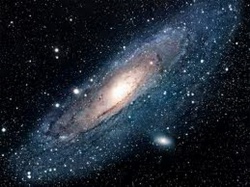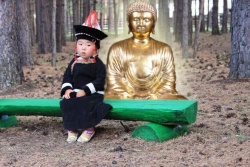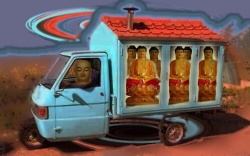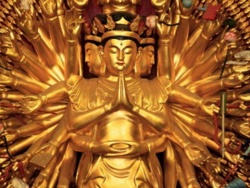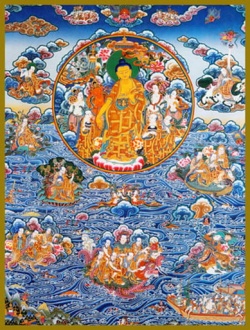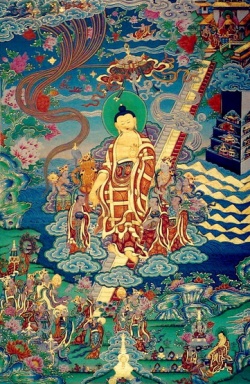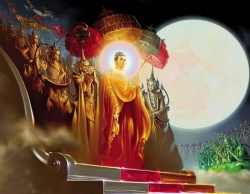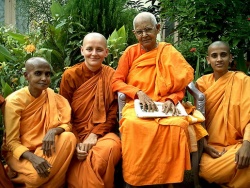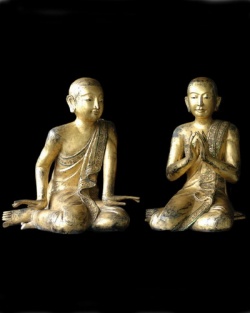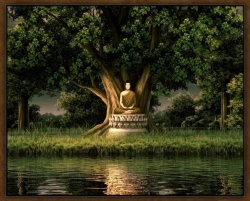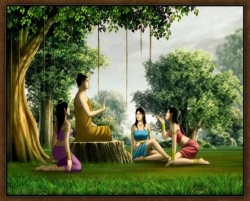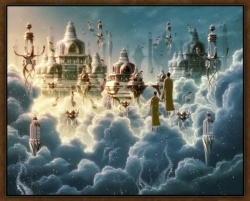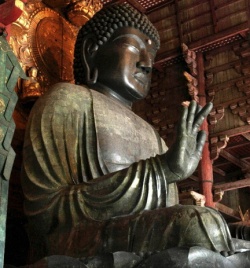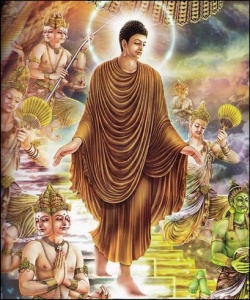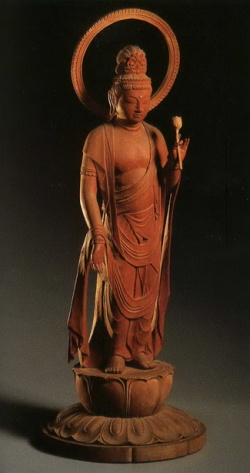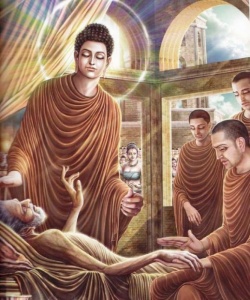Buddhism and Science
- A Conversation -
by Dr. A. P. K. Zoysa
"Individual existence impresses him as a sort of prison and he wants to experience the Universe as a single cosmic whole.
The beginnings of cosmic religious Feeling already appear at an early stage of development, as an example in the Psalms of David and in some the Prophets. Buddhism, as we have learned especially from the wonderful writings of Schopenhaur, contains a much stronger element of this".
Albert Einstein, On Religion and Science, 1930.
Buddhism proclaims no revealed Truth, neither does Science. There are as such no creator Gods, no
soul theories in the Buddhist Doctrine. It is built on the trilogy, of Anicca (Impermanence), Dukkha (sorrow, unsatisfactoriness) and Anatta (non-substantiality). The first factor in this
trilogy, Anicca is merely an experienced fact. In science it is agreed that Impermanence is an observational fact. Heraclitus the Greek Philosopher, who lived at the time of The Buddha stated that, " you cannot enter the same river twice". Post modernists inquire as to whether you can enter the same
river even once ? Impermanence (Annicca) has once again assumed centre stage in the debate on realism. Dukkha, although a subjective experience is said to be common to all states of existence. Without
Attachment to transient Phenomenon it is said that, there cannot be existence (Samsara). The inevitable separation from the pleasant and contact with the unpleasant leads to Dukkha. Such an experience although not a matter of Investigation by science is not contradicted by it.
Non-substantiality (Anatta), the lack of self in subject and the lack of an 'own nature' in perceived forms is accepted as valid experience in Buddhism. Science however speculates on the
existence of a material substance with its own nature, and postulates that all Phenomenon may be reduced to a movement of this material substance (Atomism). Although this is the case in what may be termed as
Classical science; the search for a fundamental substance has been elusive, and speculative theories on the nature of sub-atomic Phenomenon speak of resonances rather than substances (Michio Kaku, 1996). Modern theories in physics at least appears to be approaching Anatta (non-substantiality), albeit
through a tortious route. Unfortunately it is Classical science which is popular science and known to the lay public. Buddhist psychological theories are many but fall under the broad paradigm laid down by The
Buddha. In a Kuhnian sense western psychology can be classified as an immature science, with the existence of several contradictory pardigms (Jungian and Freudian as example), and as such there is
much to be learnt from the theories and practice of Buddhist psychology. The above points seem to indicate that a conversation between Buddhism and Science would be extremely interesting and fruitful.
Other than the above philosophical reasons, there are many commonplace reasons for a dialogue. Science does not comment on ethical questions, or it pretends not to. Ethical questions arising often from
its own investigations. How does humankind handle the Nuclear forces unleashed by Science and Technology ? What do we do with the probability of cloned babies and the possibility of Euthanasia ? What should be our
response when economic systems exploit the natural environment using developments in modern science for human Wealth creation; leaving little room for the continuation of other species ? These are many
questions which are asked today, but debated within the framework of Judeo-Christian cultures. A fresh look at these, from a different cultural standpoint may be a necessity for the post modern era.
The following broad topics are identified as being fruitful and topical. You are urged to read and comment on the contributions made here.
(a) Buddhist Realism and Modern Science.
(b) Ethical questions arising from developments in Bio-Technology.
(c) Buddhist views on Nuclear technologies.
(d) Is Death the 'End of story' or Birth its beginning ( or is Rebirth a fact or fiction }?
(e) Budhist and Western psychology - Comparative studies.
(f) Buddhism and the Natural Environment.
(g) Buddhist and Scientific Cosmologies.
The spirit of inquiry within which this grand conversation between Buddhism and Science will be conducted is given as a synopsis, extracted here from The Buddha's advice to the Kalamas :
"It is proper for you Kalamas, to Doubt, to be uncertain; uncertainty has arisen in you about what is doubtful......... Come, Kalamas. Do not go upon what has been acquired by repeated hearing; nor upon rumour; nor upon what is in the scripture; nor upon surmise; nor upon an axiom; nor upon specious reasoning; nor upon a bias towards a notion that has been pondered over; nor upon another's seeming ability; nor upon consideration , 'The Monk is our teacher'.
Kalamas, when you yourselves know; 'These things are good; these things are not blamable; these things are praised by the wise; undertaken and observed, these things lead to benefit and Happiness', enter on and abide in them".
" Buddhism and Modern Science- by Dr. Granville Dharmawardena, University of Colombo
" Scientific basis of Anatta Explained
Notes:
Reincarnation is Now a Scientifically Acceptable Phenomenon
by Dr. Granville Dharmawardena, University of Colombo
(Based on a Scientific paper presented at the 52nd Annual Sessions of the Sri Lanka Association for the Advancement of Science, November 1996)
In the seventeenth century when Rene Descartes divided everything in the Universe into two realms as "Res Extensa" (matter) and "Res Cogitans" (Mind), gathering Knowledge within the realm of Res Extensa was called Science and the Phenomenon of Reincarnation got pushed into the other realm Res Cogitans which was condemned to be not respectable and not up to the dignity of Scientists to probe into. Science was considered the respectable realm to study.
All important and respectable Knowledge of the Universe was thus restricted to science which was restricted to the study of the aspects of the Universe that are measurable. Scientists accepted that the Universe consisted
essentially of "objects" leading to the belief that the ultimate realities of the Universe are things and not beings. It was believed that everything in nature could be explained in terms of interactions of matter particles.
Science developed in this framework is known as "Classical Science". Classical Science had great material success because it helped to develop technology which brought about Wealth and material benefits to mankind. It
helped the West to colonise the rest of the World and acquire economic dominance and political influence.
The frame work of Classical Science was punctured by Henry Becquerel exactly hundred years ago, in 1896, by the discovery of Radioactivity. Albert Einstein cracked it at the beginning of this century by discovering the
theory of relativity. It was totally blasted by the advent of Quantum Theory and the Uncertainty Principle. It is noteworthy that Einstein's discovery falls entirely within the realm of Res Cogitans as it did not involve any experiments or measurements.
In classical science scientists made idealised Mental pictures of the Phenomena to be understood.
Imagined mechanisms were usually presented to make various Phenomena and relationships between them understood. But as Modern Science boosted man's Knowledge transcending the limitations imposed by the five senses and
took us to murky areas of nature, profound changes had to be introduced to procedures in science. Our ability to understand everything by way of perceptible Mental pictures diminished and it became necessary to imagine models
with components which behaved in ways that had no counterparts at all in the World familiar to us. Mechanisms involved in these models in most instances not only are invisible but also consist of elements that operate in ways never known in the World that we actually experience through our five senses.
For example a single electron can pass through two different holes on a screen at the same time and still remain a single particle on the other side. If we use some mechanism such as flashing a Light on the
electron to observe through which hole it passes, then it will pass only through one of the two holes. Mechanisms
of such Phenomena are beyond our imagination at least at present. Mathematical models devoid of pictorial content which are typical of modern science resulted from attempts to fit the
concepts of atoms and waves to the discoveries made at the end of the 19th century which led to
the quantum theory. Classical science usually stood for absolute precision where as modern science stands for impossibility of absolute precision.
Modern science joined up the two realms, Res Extensa and Res Cogitans and made us to understand that the Universe cannot be broken up into two independent arbitrary realms as Res Extensa and Res Cogitans. They are not independent and cannot be studied completely
independently. Within the establishment of modern science some of the aspects of nature that did not strictly adhere to the realm of Res Extensa, which were therefore earlier condemned as unbecoming of
scientists to talk about have become respectable. Reincarnation falls into this category. Therefore scientists now have the professional clearence to scientifically investigate Reincarnation. This paper does not distinguish between subtle differences among Reincarnation, Rebirth and rebecoming.
If Reincarnation is to be examined from an unbiased scientific point of view, it is necessary first of all to find a way of bypassing such unscientific barriers as religious bias. This can be done by considering the standard
procedure used at present for the acceptance of any modern scientific theory and testing Reincarnation by following the same procedure.
Geremy Hayward has described how one ventures to deal with a new theory. He describes this procedure as a four step scientific process as follows;
a) study the relevant Phenomenon,
b) formulate the new theory,
c) use the theory to predict observations that we should be able to make if the theory is correct, and
d) look for these predicted observations.
Richard Feynman, Noble Laureate for Physics, describes this process in detail. He combines steps "a" and "b" and describes it as a three step process.
If the observations made in the last step do not agree with the predictions of the earlier step the proposed theory is not acceptable. If they agree the theory becomes acceptable. If more and more observations show agreement the
theory receives stronger scientific acceptance. Once a theory becomes scientifically accepted by this test it remains so unless someone finds reliable new data to prove its unacceptability.
Reincarnation is a very old belief and a large fraction of the World population believes it. For example Rene Descartes' statement "What I have said is sufficient to show clearly enough that the extinction of the
Mind does not follow from the corruption of the Body and also to give men the hope of another Life after Death." in 1641 confirms his belief in Reincarnation. About 20 percent of those in the Western
World whose religions shun Reincarnation nevertheless believe it. According to opinion polls this percentage is rising.
Hence the Phenomenon of Reincarnation is already known and therefore the steps "a" and "b" are already there. In examining the scientific acceptability of Reincarnation therefore one has only to go through the last two steps of
the above scientific process. If this is done successfully the scientific acceptability of Reincarnation is proved in the way any other theory of modern science is proved.
Reincarnation may be defined as the re-embodiment of an immaterial part of a person after a short or a long interval after Death, in a new Body whence it proceeds to lead a new Life in the new Body more or
less Unconscious of its past existences, but containing within itself the "essence" of the results of its past lives, which experience goes to make up its new character or personality. Thus,
infancy brings to earth not a blank scroll for the beginning of a new earthly record, but it is inscribed with ancestral histories, some like the present scene, most of them unlike it and stretching back into the remote past.
Reincarnation is an issue of utmost importance, one that promises to touch the ordinary man, woman and child in a profound and far reaching way. Crime statistics show that convictions are much lower among those who
believe in Reincarnation than among the others. If scientifically accepted, Reincarnation will have a stake in defining human identity in the 21st century.
There are two possible scenarios, No-Reincarnation scenario and Reincarnation scenario that can be considered. Human being is composed of the Body and an immaterial part. The Body which is the material part is well
understood because it fell within the Classical Science realm of Res Extensa and was extensively studied by
scientists. The immaterial part has not been studied by scientists because it fell within the Classical Science realm of Res Cogitans.
In the No-Reincarnation scenario Death is something like the Event Horizon of a black hole. Crossing the event horizon is a one way journey and after crossing it nothing can come back, not even Light. Here the Body
disintegrates after Death and the immaterial part either annihilates or gets into a scientifically
unknown state and remains there for ever, ie. each individual is borne, lives one Life time and at the end of it passes the event horizon of Death to a state of no return.
n the Reincarnation scenario Death is not an event horizon because only the Body, the material part, disintegrates and goes into a state of no return. The immaterial part enters into a scientifically unknown state and reappears, after a period.
The above description of the Phenomenon of Reincarnation constitute steps "a" and "b" of the scientific process. The next step of the scientific process is looking for observations that can be predicted assuming the existence of
this Phenomenon, observations that have a reasonable chance of being practically examined.
Abilities of individuals to carry memories of past events differ widely from
individual to individual. Some people can remember events and experiences of long past whereas some easily forget things within a few years. Most people vividly remember special events such as tragic
happenings for a very long time, even up to Death. Under hypnosis people recollect events which they had completely forgotten. Some people have the exceptional ability to recall Knowledge and experiences gathered long ago and use them when necessary. For example a friend of mine who had been discussing Advanced Level
Physics with me when he was studying for the GCE AL exam long time ago, but never did any science there after escaped injury in the Central bank bomb blast by instantaneously recalling his memories discussing AL
Physics. But others who had studied Physics more recently lost their Eyes because that memory didn't flash back to their rescue at the time of impending disaster. As soon as my friend saw the flash of
the bomb blast from his window , AL Physics flashed back to his Mind and prompted to him that the shock
wave comes a little while after the flash. Instantaneously he threw himself back flat on the floor before the shock wave blasted the window glasses.
If Reincarnation as defined earlier is true it should be possible to extend some of the above human capabilities, which result from immaterial aspects of the human being, beyond birth to the previous Life and even
beyond to earlier lives. Some people should be able to remember events in their past lives. Hypnosis must enhance this ability. Some must be able to make use of Knowledge and experiences of past lives.
With these predictions we can move on to the last stage of the scientific process, to look for these predicted observations.
A large amount of data has been accumulated by research workers around the World on matters relating to Reincarnation.
" spontaneous recall of past lives,
" past Life therapy,
" child prodigies and others who can make use of Knowledge and experience
gathered in their past lives are some of the aspects that have been subjected to much research and Investigation.
The observations made on the above areas agree with the predictions made in the third stage of the scientific process thereby successfully completing the four step test for scientific acceptability. No scientifically acceptable
data that can go to prove the scientific unacceptability of Reincarnation have appeared in scientific literature so far.
On the basis of these tests it is concluded that the scientific acceptability of the Phenomenon of Reincarnation is proven at least on three counts in terms of the accepted principles of modern science.
A science minded person often finds it difficult to accept Reincarnation because he/she had failed to perceive a Reincarnation mechanism that is intelligible within the outdated Decartes'
classical science frame work. But Modern Science, specifically Quantum Mechanics, has compelled us to accept unintelligible mechanisms of natural Phenomena like the behaviour of electrons and we do not
hesitate to accept them. Likewise with the data available we are compelled to accept Reincarnation as a reality.
Austrian Scientist Rudolf Steiner says,
"Just as an age was once ready to receive the Copernican theory of the Universe, so is our age ready for the idea of Reincarnation to be brought into the general Consciousness of humanity".
Buddhism and Modern Science - by Dr. Granville Dharmawardena, University of Colombo
"Buddha is the greatest scientist in the history of mankind."
I have often heard this at bana sermons. This is completely wrong. Scientists are people who are constrained to work solely within and accept only, the Knowledge generated by the scientific method. They generally
reject Knowledge generated by the other method. The Buddha did not use the scientific method and therefore he is not a scientist.
Of the two methods of acquiring Knowledge available to the human being The Buddha used the right brain centered intuition method, where as the western approach to acquiring Knowledge used
the left brain method. The Buddha trained his Mind to an extreme high state of Enlightenment (Buddhahood) from where he could understand the true reality of nature in its totality. It is based on
such Knowledge that he propounded a philosophy which is most conducive to balanced and happy living which leads to living in Harmony with others, living in Harmony with nature, meaningful living devoid of stress,
anxiety, jealousy and empty pride, ultimately ending up in a meaningful state full of bliss. That was over 2500 years ago. Science began much later.
Science is often explained as systematic formulated Knowledge. It is Knowledge needed to understand the Phenomena that we observe and those that influence our lives. For the early man science represented a
cumulative process of increasing Knowledge and ability to understand what is around him. It also meant a sequence of victories over Ignorance and superstition. During the time of The Buddha, science was still
speculative explanation of common sense observations by intellectuals who devoted much of their time for Thinking and understanding natural Phenomena. Science helped to develop technology essential for producing things needed to make Life more comfortable.
During the seventeenth century the French Mathematician Rene Des Cartes restricted the scope of science to only what is material by bifurcating the Universe as matter (res extensa) and Mind (res cogitans)
and limiting science to the study of the former. The science that evolved on the basis of Cartesian
bifurcation was confined to material objects within the limits of Perception of human sensory organs which are unable to perceive anything that extended beyond three spatial dimensions.
The above constraints on science stood on the way of achieving its desired objective of understanding the true reality of nature, because nature and natural Phenomena are neither confined to matter nor to
three spatial dimensions. Many of the important Phenomena of nature therefore happened to be outside the scope of science. Science, nevertheless, has provided enormous material benefits to mankind. Therefore people
all over the World have very high confidence in science and accept anything explained to them in terms of science. The ultimate aim of science is understanding the true reality of nature, minimizing
human Suffering and making human beings happy by way of providing material comforts.
The Buddha's way of acquiring Knowledge by intuition was not subject to the limitations that stifled science and therefore unlike science the Knowledge that The Buddha acquired is complete and represents the
true reality of nature. This is confirmed by over 2500 years of experience. For this reason The Buddha did not have any grey areas that need to be hidden under a cloud of imaginary superhuman force.
Just as in science Buddhism does not require its followers to have dogmatic belief in anything that The Buddha taught. The Buddha advised people not to blindly accept what he taught, but research on them for
themselves before accepting. For this reason his teachings have remained unaltered and valid for all times and under all circumstances.
While the Knowledge The Buddha acquired represents the true reality of nature, what scientists aspire to understand as the ultimate destination of the scientific method, is also the same true reality of nature.
While the goal of the teachings of The Buddha is elimination of human Suffering and making human beings
happy and contented by way of training their minds and creating self discipline in them, the goal of science is providing mankind with material comforts.
In 1905 Albert Einstein broke through the three dimensional barrier in science and took the scope of science beyond three spatial dimensions and Des Cartes restrictions. This enabled man to aspire for a more
realistic view of nature and natural Phenomena through the scientific method. Modern twentieth century science that developed after transcending the dimensional barrier by twentieth century scientists
such as Albert Einstein, Erwin Schrodinger, Louis de Broglie, Paul Dirac, Werner Heisenberg, Richard Feynman, Murray Gellman, Sir Arthur Eddington and Stephen Hawkin is based on the
theory of relativity, quantum mechanics and uncertainty principle. These have annihilated the artificial Cartesian bifurcation and extreme materialism in science. By the mid twentieth
century the process of gathering scientific Knowledge constituted of well organized laboratory and field experimentation, observation, development of theory, prediction, verification of the predictions and general acceptance.
Transcending the three dimensional barrier and taking science beyond the capabilities of human sensory organs eliminated the need to present perceptible mechanisms of observed Phenomena as an acceptance
criterion. The advent of computers has greatly enhanced the capability of the human brain to tackle complex Phenomena that are too formidable to be tackled by the unaided and unenlightened human brain. Computer can
never aspire to acquire the capabilities of the human brain because the human brain is driven by Consciousness which operates at a speed much faster than the speed of Light.
The main achievement of the success of the twentieth century scientists in transcending the three dimensional barrier is acquiring a more realistic understanding of nature and natural Phenomena. Twentieth century
transcended science enables us to scientifically confirm that such concepts as Impermanence, Rebirth, telepathy and selflessness taught by The Buddha are true Phenomena
of nature which are beyond three spatial dimentions and therefore beyond classical science.
Derek Parfit of Oxford University (probably the World's most important living Philosopher) accepts the Buddhist view of Life and selflessness. He believes that his acceptance of selflessness which was inspired by split brain research, has liberated him from the prison of self. He says,
"When I believed that my existence was such a further fact, I seemed imprisoned in myself. My Life seemed like a glass tunnel, through which I was moving faster every year, and at the end of which there was darkness. When I changed my view, the walls of my glass tunnel disappeared. I now live in the open air."
Derek Parfit, Fritj of Capra (the well known Nuclear Physicist) and Gary Zukav accept the Buddhist view of matter and believes in the need to liberate ourselves from the prison of material particles.
The process of human reproduction is explained in Buddha's teachings as parental union when mother is fertile and the arrival of Consciousness. The former supplies the full complement of chromosomes
needed to create a Zygote which by normal cell division creates the physical Body. The arrival of Consciousness into the physical Body makes it an individual. Stating with the creation of test tube
babies in 1968 by Dr. Robert Edwards's team of scientists at Cambridge University, incredible advances, culminating in cloning in 1996, have taken place in reproductive biology. Yet all these advances
have only shifted the site and altered the mechanism of creation of the zygote. The maturing of the zygote to a foetus, making it an individual by the arrival of Consciousness and birth remains as per Buddha's teachings.
It is now increasingly becoming clear to those who reach the front lines of modern science that what science has been discovering a new had been known to The Buddha over 2500 years ago. This is confirmed by the following statements made by topmost scientists of the twentieth century.
Albert Einstein regarded as the father of the theory of relativity says,
"Individual existence impresses him as a sort of prison and he wants to experience the Universe as a single cosmic whole. The beginnings of cosmic religious Feeling already appear at an early
stage of development, as an example in the Psalms of David and in some of the Prophets. Buddhism, as we have learned especially from the wonderful writings of Schopenhaur, contains a much stronger element of this."
Niels Bohr who developed the presently accepted model of the atom together with Earnest Rutherford says,
"For a parallel to the lesson of atomic theory….. (we must turn) to those kind of epistemological
problems with which already thinkers like The Buddha and Lao Tzu have been confronted, when trying to harmonize our position as spectators and actors in the drama of existence."
The most eminent Nuclear Physicist, Robert Oppenheimer, who produced the first atom bomb says,
"The general notions about human understanding … which are illustrated by discoveries in atomic physics are not in the nature of things wholly unfamiliar, wholly unheard of, or new. Even in our own culture they
have a history, and in Buddhist and Hindu Thought a more considerable and central place. What we shall find is an exemplification, an encouragement and a refinement of old Wisdom." - Robert Oppenheimer.
The main teaching of The Buddha is the Noble Eight Fold Path. D. T. Suzuki writes about the first item of this Path, right seeing as,
"The seeing plays the most important role in Buddhist epistemology, for seeing is at the basis of knowing. Knowing is impossible without seeing; all Knowledge has its origin in seeing are thus found
generally united in Buddha's teachings. Buddhist Philosophy therefore ultimately points to seeing reality as it is. Seeing is experiencing enlightment".
The teachings of The Buddha, founded on the basis of the true reality of nature, have been recognized to be valid at all times and under all conditions. Buddhism is the only Doctrine based on the true reality of
nature in its totality available to mankind. It is now becoming increasingly clear that solutions to most human problems that arise as a result of over indulgence, excessive competition and exploding Greed leading
to acquiring and amassing unlimited Wealth, increasing violence, terrorism, drug addiction and self destruction lie in the teachings of The Buddha. It is clear that Buddhism is getting accepted, the World over, as the way of Life of intelligent people in the third millenium.
Scientific basis of Anatta Explained
Over 2500 years ago, The Buddha understood and realised through his direct experiential Knowledge (as against a celestial message) the true nature of the Universe and expounded to the World the unprecedented Power of
the Mind. Buddha was the first to expound the theory of Anatta, the denial of existence of a soul. It revolutionised the minds of the "intelligent" and pushed them on the Path to 'Wisdom'.
Not only the Theory of Anatta until the time of The Buddha nobody has fully understood or realised concepts such as telepathy and Rebirth. The Buddha by Kalama Sutta opened his
teachings to everyone and invited all to examine question and investigate the Truth of the teachings.
Dr Granville Dharmawardena in 1996 through his own research and investigations presented proof that Rebirth is a scientifically acceptable natural Phenomenon which paper "Beyond the Net" carried. Now Dr Dharmawardena has
developed a scientific model of the 'Body-brain and Consciousness' which he claims explains the scientific basis of the Theory of Anatta and the mechanisms of Rebirth, telepathy and
clairvoyance. Here we present the paper published by Dr Dharmawardena on the scientific basis of Anatta theory. Dr. Dharmawardena is a Nuclear Scientist who holds a Ph.D. Degree from the
Cambridge University. He has had training at Harvard University, Australian School of Nuclear Technology and French Atomic Energy Commission. He is the Director of the Radioisotope
Centre, University of Colombo. He has also served as the Dean of the Faculty of Science of the University of Colombo, Chairman of Sri Lanka Atomic Energy Authority and Consultant to Monash
University (Australia). He was awarded the Gold Medal for the Most Outstanding Scientist in Sri Lanka in 1984.
INTERNATIONAL BRAIN RESEARCH ORGANIZATION ( IBRO ) INTERNATIONAL BRAIN RESEARCH PROGRAM LECTURE TEAM PROGRAMME
1 - 9 DECEMBER 1999, COLOMBO
A QUANTUM MECHANICAL MODEL OF THE BRAIN AND Consciousness
BY DR. GRANVILLE DHARMAWARDENA
UNIVERSITY OF COLOMBO.
PO Box 1490, Colombo -03
Sri Lanka.
Psychologists often speak of the Mind and the Body as two separate entities for convenience, but most acknowledge that they are intimately entwined. Yet none knows exactly how or how intimately. So
the Mind Body problem keeps stubbornly resisting a definite solution. Philosopher John Searle ( Mills Professor of Philosophy, University of California, Berkley ) says that today's
philosophers are reluctant to tackle such big problems as how people have been trying to understand their relationship to the Universe.
All these refer to the elusive relationship between the Body and the Mind referred to more generally as the brain Mind problem. Brain Mind relationship has baffled mankind for a very long time . One
main reason for this is that it was not considered as a candidate for scientific study until recently.
Psychology and related sciences were able to continue for many years by either ignoring the brain
entirely or at best treating it as a black box whose rules of operation could be understood without reference to its internal contents or composition.
Human brain without Doubt is the most complex organ in the Universe. It is physical and biological. Therefore it has to be amenable to scientific probing without the intervention of such
considerations as the Godels theorem, which states that there are statements in mathematical systems which are true but cannot be proven within those systems.
Consciousness on the other hand is neither physical nor biological. Therefore it is a more elusive
subject to deal with and Godel's considerations may have a role to play there. Attempts to understand brain and Consciousness have been mostly based on restrictive Newtonian classical science and exclusively material realm.
Although the powers of understanding of human senses and the scope of Newtonian science are limited to three spatial dimensions, the scope of our Universe is not limited to three dimensions. Many of the
natural Phenomena happening within our Universe transcend the three dimension scene. Therefore it is not possible to assume that the mechanisms of operation of the brain and Consciousness remain imprisoned within the confines of Isaac Newton's three dimensional material Universe.
Attempts to understand the brain-Mind problem within Newton's Universe over centuries have introduced divisions and concepts that have become detrimental to having a new look at it from the point of
view of modern science, more specifically quantum mechanics.
Intellectual acrobatics within the domain of classical science to find solutions to a problem that
transcends the limits of classic science cannot yield any valid solution.
In trying to interpret the mechanisms of operation of the human brain and developing a model for
Consciousness that explain all practical observations, it is necessary first of all to jettison traditional baggage and clean up the scene. It is also necessary to enlist all the observed properties of the brain and Consciousness and ensure that the developed model explains all of them.
There is general agreement that the seat of Consciousness is the brain. We can go along with this concept. Philosopher Colin McGinn (Professor of Philosophy at Rutgers University,
New Jersey the USA ) introduces a property P of the brain in Virtue of which the brain is the basis of Consciousness and a theory T, referring to P, which fully explains the
dependence of conscious states on brain states. He adds that if we knew T, then we have a constructive solution to the Mind-Body problem.
It is reasonable to consider a property P of the brain , but it is not possible at this stage to shut the possibility that, as Nobel Laureate Neurobiologist Sir John Eccles points out, the scope of Consciousness may
not remain limited within the confines of the human skull. This is specially so because many of our practical observations and those of many others clearly show that Consciousness at times can remain completely
disembodied. We can hence, focus our attention on understanding three factors, viz., the nature of Consciousness, the property P of the brain that enables Consciousness to operate within the brain
and a model that explains the behavior of the brain and Consciousness as practically observed.
Brain which is material has received much attention over a very long period from both classical and
modern scientists. The classical science explanation of the structure and the mechanisms of operation of the brain is easily accessible through medical and biology text Books. The
brain consists of about 1.3 kg. of gray matter which is made up of dozens of billions of specialized cells known as neurons which have electrical properties akin to those of transistor circuits in computers.
Like in transistor circuits these cells are interconnected and there are trillions of such neuron-neuron connections in the brain. Like in transistor circuits electrical signals are transmitted through neurons
by unidirectional electrical pulses which are excited, modulated or inhibited by pulses in other neurons, and passed on to other neurons.
However there are differences. In transistor circuits electrical pulses are transmitted across the circuits by the migration
of electrons at an enormous velocity of half the speed of Light, where as in neurons, electrical pulses are transmitted by the movement of ions which are much heavier than
electrons, at a much slower maximum speed of 120 meters per second. This speed is not fast enough to account for the speed of human actions. The interneuron links are established through biochemical
junctions, through which signals are passed from one neuron to another by the release of ions. In transistor circuits all connections are exclusively electrical.
Brain is the most complex and most important (from hierarchy point of view ) organ in the human Body and it is a voracious consumer of energy, consuming ten times more energy per unit mass
as compared to other Body organs. Failure to supply energy to the brain for a few minutes can cause substantial brain damage and ultimate brain Death. The variety of different
proteins expressed in neurons is about 30,000. This is greater than in any other Body organ.
The importance of understanding the structure and mechanisms of operation of the brain prompted
President George Bush of the USA to proclaim the 1990's as the decade of the brain. EEG (Electro Encephelo Graph ) was the original technique used to study brain mechanisms. Three new techniques, PET
( Positron Emission Tomography ), MRI ( Magnetic Resonance Imaging ) and Magneto Encephelography have come into
use in studying brain mechanisms during the last decade . As a result we understand the functioning of the brain much better today than a couple of decades ago.
The slow electrical pulses moving at a maximum speed of 120 mps may, perhaps, be adequate to account for some of the involuntary functions inside the human Body. But they are certainly not adequate to account for the
speed of human activities that involve computing and the Mind. The similarities between the computer circuits and the brain cells have driven brain researchers to construct
computer models for the brain. Initially they tried serial computers and then to account for the speed parallel computers came in. Today computer models dominate most brain research.
However computer models are many orders of magnitude slower than needed to account for the speed of human beings. A Neurologist has calculated that if the brain was a standard serial or a parallel
computer it would take more time than the age of the Universe to perform all the necessary calculations associated with just one perceptual event. But if the brain were a quantum computer, it
would try out all the various possible combinations of data arrangement at once and thus unify its experience.
Many who research on the brain-Mind problem proceed with the a priori assumption that
Consciousness is an emergent property of the brain. They consider Consciousness as another property, emerging as a result of P from trillions of electrical pulses shuttling across the brain. According to this
assumption Consciousness is only a property and not an entity. John Searle introduces Consciousness as a natural biological Phenomenon that does not fit comfortably into either of the
traditional categories of Mental and physical, caused by lower level micro processors in the brain. However on the basis of practical observations made by us and many others we have to reject these
assumptions and regard Consciousness as a non-material entity capable of independent existence.
Observations on OBE (Out of Body Experience ) and NDE (Near Death Experience ) show that while the Body is in an anaesthetized or inactive state Consciousness can remain disembodied, observe events from outside
the Body and later relocalize in the brain. After the Body renormalizes the person can relate what his Consciousness observed and heard from an out of Body location while the Body was inactive. Other
experiments have shown that Consciousness can leave a dying person, float around observing things and events and
later, as Eccles had pointed out, attach itself to an unborn foetus to start a new existence as another individual.
Consciousness is therefore a non material entity capable of independent existence and not a
property. Consciousness is not emergent. It can remain localized in the human brain and interact with the brain through the property P of the brain and thereby control the activities of the human
Body. Whenever the property P collapses Consciousness can leave the brain and go into an independent floating existence.
This behavior of Consciousness is akin to the behavior of an electron in and out of an atom. Electron which is a quantum entity can remain localized inside an atom by
quantum mechanical interaction with the electromagnetic field around the atomic nucleus, which itself is quantum in nature, so long as the energy of the atom's quantum state it occupies matches
the energy possessed by the electron. Whenever the energy of the electron does not match, it has to shift to another matching state or leave the atom and start floating as a free electron. In this
case the property that localizes the electron inside the atom, the nature of the electron and the relevant atomic model are well known. All these are quantum in nature.
Let us consider the nature of Consciousness, the property P of the brain and a model that satisfactorily solves the brain-Mind problem.
Nature of Consciousness
Defining Consciousness has been considered as a frightfully difficult problem. Does the word " Consciousness " have one single meaning or does it have two meanings like the words " bank " and " palm ". In my mother tongue,
Sinhala, and in Sanskrit there are two separate words with separate meanings relevant to this problem. Words " Smruthi " and " Vignana " in Sanskrit have two separate meanings and the English word " Consciousness " is a common word that covers both these meanings.
The " Vignana " meaning of Consciousness refers to the non-material entity which is capable of independent existence and interacts with the brain through the property P. Let me use the word "
Consciousness " to mean this entity. The " Smruthi " meaning of Consciousness refers to a state created by the interaction of the above entity with properly functioning brain and sense organs. It is
what a person loses when he/she is anesthetized or receives a hard blow on the head. Let me use the term " S-Consciousness " to refer to this state.
Quantum Physicist Danah Zohar describes Consciousness as something that includes general capacity for awareness and purposive response. By this description she accepts the above two meanings of the word
Consciousness. Roger Penrose refers to these as active Consciousness and passive Consciousness.
When a person is awake Information about his/her surroundings is presented to his/her brain by his/her
sense organs. The brain processes and computes millions of bits of Information presented to it every second by the sensory organs and presents the processed Information to Consciousness.
Through this process Consciousness remains aware of the surroundings and we say that the person is s-conscious of his/her surroundings. When this link between Consciousness and the surroundings is interrupted and
Consciousness is not able to be aware of events in its surroundings we say that the person is s-unconsciousness. It has been found that when a stimulus is presented to a sensory organ of an
anaesthetized person all brain processes relevant to that stimulus takes place as if he/she is not anesthetized. Physicist and Pharmacologist Susan Greenfield ( Professor of
Pharmacology at Oxford University and Professor of Physics at Gresham College, London ) points out that none has yet pointed to a single event that occurs in awake but not in anaesthetized brain.
Hence when a person becomes s-Unconscious, the property P breaks down and severs the link between Consciousness and the brain.
In that state it is possible that Consciousness can disembody and observe events in the surroundings directly
without the help of sensory organs, keep them in memory and relate what was seen, after Consciousness returned to the Body and re-established links with the brain. According to our observations the disembodied Consciousness possesses visual, auditory and olfactory senses.
It has been shown using such techniques as PET and MRI that the above process of receiving data from a stimulus by a sensory organ, transmitting them to the brain, computing and processing the
data and passing the processed data to Consciousness, can be reversed by hypnotizing a person. When a hypnotherapist suggests, for example, that he/she is seeing red Light to a hypnotized subject, all
above processes take place in the brain as if the subject is actually seeing red Light.
The ability of a person to describe what his/her Consciousness had observed or heard while it is in a disembodied state makes us to believe that memory is, at least partly, non-material.
Several decades ago David Bohm pointed out many striking similarities between the behavior of our Thought processes and that of some quantum processes. For example while entertaining a vague
train of Thought, the act of concentrating on one in order to bring it into better focus, changes the original sequence. Like electrons governed by Heisenberg's uncertainty
principle, which are never the same again once they have been looked at or measured, a Thought which has been highlighted through attention is different from the vague musing which preceded it. The focused Thought has "
position " like the particle aspect of an electron's two sided nature, whereas the vague musing has " momentum " like the electron's wave aspect. We can never experience both simultaneously. This is a characteristic feature of a quantum entity.
Quantum systems are essentially unified, so are our Thought processes. David Bohm says, " Thought processes and quantum systems are analogous in that they cannot be analyzed too much in terms
of distinct elements, because the " intrinsic " nature of each element is not a property existing separately from and independently of other elements but is instead a property that arises partially from its relation with other elements ".
Danah Zohar analyses the quantum like behaviour and concludes that Consciousness functions, according to the laws of quantum mechanics.
We can conclude that Consciousness is a quantum mechanical entity that can have an independent existence. It can localize in the human brain when the property P provides the
necessary quantum mechanical base conducive for it to interact with and function in the brain. When the property P breaks down, Consciousness takes flight and starts floating. It takes away with it at least a part of the
contents of the memory. It possesses the ability to acquire visual, auditory and olfactory Information in spite of the fact that there are no sense organs associated with it.
Property P of the Brain that Establishes Brain Consciousness Interaction
In most attempts to solve the Mind-Body problem, it is assumed that computers can be used to simulate or model Mental and neuro-biological processes in the brain and this can explain Consciousness. Roger
Penrose ( Rouse Ball Professor of Mathematics, Oxford University ) points out that quantum mechanics and Godel's theorem makes us to reject these assumptions.
John Searle points out that a brain made of neurons is aware of what it is dealing with whereas a computer modeled to simulate some activity of the brain cannot be aware of what is
being dealt with inside it. Penrose points out that there is something in the physical actions in the brain that evokes awareness. This aspects is beyond computation. Also it has been pointed out that anything
that is infallible cannot be intelligent. Computer being infallible cannot be intelligent. A
computer model of the brain cannot explain the distinctive indivisibility of our thoughts, perceptions and feelings.
In most standard brain models, Mind is believed to emerge from trillions of signals shuttling across billions
of neurons in the brain. A brain structured on mechanical principles cannot account for the property P that can create s-Consciousness by interacting with Consciousness.
Recent EEG experiments carried out by a team of physicists at Southampton University
( England ) confirms that Thought processes are quantum in nature. Here the effect of
measuring right and left brain activity on a left brain task was tested. They found that measuring left brain EEG improves performance whereas measuring right brain EEG
disrupts it. In another experiment it has been found that measuring the left brain EEG makes a right hand activity more accurate.
The major stumbling block in solving the brain Mind problem had been how does the brain-Mind bind together millions of disparate neuron activities into an experience of a perceptual whole. How
does the " I " or " Self " or the perceived wholeness of my World emerge from a system consisting of so many parts, billions of neurons. What creates the " Oneness " or the " Globality " of Thought processes
? What creates individuality and " I " ness or " self "? What creates feelings, Free will and creativity ?
No mechanistic system consisting of separate interacting parts could give rise to above. What are the structures in the brain that create the property P which grant us access to the quantum realm ?
It has become clear that to explain the property P one has to consider the most highly ordered and highly unified structures
possible in the Universe. The structure that possesses both characters ,the most highly ordered and most highly unified is the Bose-Einstein condensate.
In classical science the most ordered structure that we can find is the Crystal. Crystals are rigid, immovable structures. In Bose-Einstein condensates, the quantum properties allow both a " fluid " order and
a high degree of unity. Each particle in a Bose-Einstein condensate fills all the space and all the time in whatever container that holds the condensate. Many of their characteristics are
correlated. They behave holistically as one. The condensate acts as one single particle. There is no " noise " or interference between separate parts. This is why super fluids and super conductors have their special frictionless qualities
and laser becomes so coherent. Super conductors , super fluids and lasers are Bose-Einstein condensates. The photon of a laser beam overlap their boundaries and behaves as one single photon and the whole system can be described by a single equation.
Super conductors, super fluids and lasers are either very low temperature or very high energy systems. Super conductors and super fluids loose their quantum coherence long before they reach room temperature. Quantum coherence
at Body temperature in Body cells was found by Herbert Frolich. Prior to that quantum physciscist Fritz Popp discovered that biological tissue emits a weak glow when stimulated at the right energy levels .
Cell walls of biological tissue contain countless proteins and fat molecules which are electrical dipoles. When a cell is at rest these dipoles are out of phase and arrange themselves in a haphazard way. But when they are stimulated they begin to oscillate or jiggle intensely and broadcast a tiny microwave signal. Frolich found that when the
energy flowing through the cell reaches a certain critical level, all the cell wall molecular dipoles line up and come into phase. They oscillate in unison as though they are suddenly coordinated. This emergent quantum
field is a Bose-Einstein condensate and has holistic properties common to any quantum field.
Dana Zohar points out that ion channel oscillations in neurons are quantum Phenomena which generate a Frolich like coherent electric field. There are ion channels ( protein molecules ) lining the membrane walls of individual neurons, which open or close in response to electrical fluctuations
resulting from stimulation. They act like gates to let Sodium , Potassium and other ions through.
They are of a size to be subject to quantum fluctuations and superposition. Each channel as it oscillates
generates a tiny electric field. When a large number of ion channels ( there are 10 million in each neuron ) open and close in unison, as they do when stimulated, the whole neuron fires or oscillates
and a large scale electric field is generated across the neuron. Certain neurons act as pace makers. When a pacemaker neuron oscillates in response to a stimulation whole bundles of neurons
oscillate with it. A finding by a neurobiologist that when a person sees an object all neurons in the Cerebral Cortex , associated with that perceptual object, oscillates in unison regardless of their location in the brain.
Danah Zohar suggests that the original ion channel oscillations are quantum Phenomena which, as in Frolich systems , generates a coherent quantum electric field. It is a Bose-Einstein condensate.
Existence of such large scale coherent electrical fields across the brain explains how a large number of disparate and distant neurons can integrate their Information to produce a holistic picture. The
proof fairly recently that nonlocal ( instantaneous or faster than Light ) quantum correlations exists between particles apparently separated in space and time has helped us to understand these effects.
The crucial distinguishing feature of Bose-Einstein condensate is that many parts which go to make up the ordered system not only behave as a whole , but they become whole. There identities merge and overlap in such a way that
they lose their individuality entirely. This is a quantum property. Such a large quantum synchronicity exists in and accounts for the special properties of lasers, super conductors and super fluids.
Only this type of quantum correlated condensed state could explain the unbroken wholeness of Thought process.
The property P of the brain which is the non local quantum correlate, or the Bose-Einstein condensate behaves as above . It creates a unity from the diverse bits of Information drawing them to a
meaningful whole. The millions of sensory data from sense organs received every moment are chanelled to various disparate areas of the brain and processed by the computing facility of the brain.
Consciousness receives this processed Information through P and creates a holistic scene.
It is this integration of all the processed bits of Information to create a one whole that creates the
identity as a person , the self or the " I " ness. Here P is the coherent non local quantum correlation of the brain and it is an emergent property.
Model of The Body-Brain- and Consciousness
From the above considerations it is possible to propose a three tier model for Body- Brain and Consciousness, where the brain is sandwitched between the Body and Consciousness. Here the
brain-Body link is mechanical and it is fairly well understood from classical science considerations. Body and brain operate in Einstein's space-time domain where non locality is forbidden.
The brain Consciousness link is established by the property P which links the brain to the quantum domain where nonlocality can operate . Consciousness is a non material entity in the
quantum domain that is capable of independent existence. Consciousness can remain localized in the brain so long as the emergent quantum property P is functional , just as an electron which is a
quantum entity can remain localized in an atom so long as the energy of the electron matches the quantum state it occupies. Whenever the property P breaks down or becomes weak Consciousness
can leave the brain and take up a floating existence in the way an electron leaves its atom if it acquires excess energy and starts a floating existence as a free electron. Consciousness can return to the brain if the property P is re-established.
This model explains all the observed properties of Consciousness including NDE , OBE and Reincarnation. Since all Information transfer in a non local quantum correlation is instantaneous, it explains the
speed of human action. It can be extended to explain Phenomena such as telepathy. It explains the individual identity or the " I " ness or self.
References
1. The Mystery of Consciousness - John Searle, Granta Books, London - 1998.
2. The Human Brain - A Guided Tour - Susan Greenfield, Wiedenfield and Nicolson, London - 1997.
3. The Large, The Small and the Human Mind - Malcolm Longair - Cambridge University Press - 1999.
4. From Brains to Consciousness - Essays on the New Sciences of the Mind - Steven Rose - Penguin Books - 1998.
5. An Elementary Textbook of Psycho - Analysis - Charles Brenner, Doubleday Anchor Books - New York - 1957.
6. Psychology Today, An Introduction - J. Jay Braun and Darwyn E. Linder - Random House - New York - 1979.
7. Minds, Brains and Science - John Searle, Harvard University Press - 1997.
8. The Problem of Consciousness - Colin McGinn - Blackwell - 1996.
9. The Quantum Society - Mind, Physics and a New Social Vision - Danah Zohar and Ian Marshall, Flamingo - 1994.
10. Scientific Acceptability of Rebirth - Granville Dharmawardena - Foundation for Buddhist Research - Sri Lanka - 1998.
11. Many Lives Many Masters - Leslie Bryan Weiss - Translation by J. Wijesekera - Hitec Prints - 1998.
12. The Quantum Self - Danah Zohar, Flamingo - 1991.
13. The Astonishing Hypotheis - The Scientific Search for the Soul - Francis Crick - Simon and Schuster - 1995.
14. Shadows of the Mind - Roger Penrose - Vintage - 1995.
15. Frolich. H, " Evidence for Coherent Excitation in Biological Systems " - International Journal of Quantum Chemistry Vol. XXIII, 1983.
